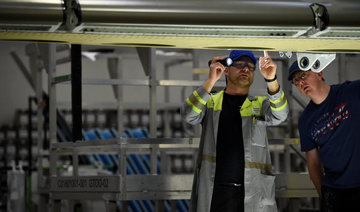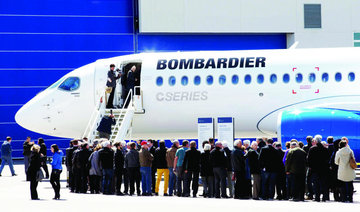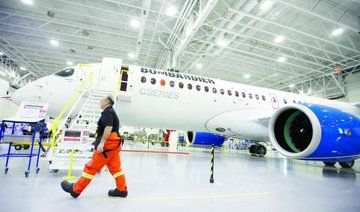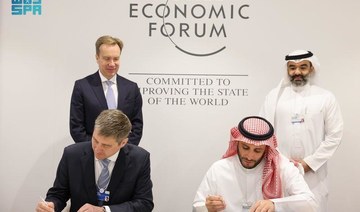WASHINGTON: The US Commerce Department has notched up proposed trade duties on Bombardier CSeries jets to nearly 300 percent, affirming Boeing’s complaint that the Canadian company received illegal subsidies and dumped the planes at “absurdly low” prices.
The decision underscored the defensive trade policy of US President Donald Trump, and could effectively halt sales of Bombardier’s innovative new plane to US airlines by quadrupling the cost of the jets imported to the US.
The Commerce Department proposed a 79.82 percent antidumping duty on Friday, on top of a 219.63 percent duty for subsidies announced last week.
The new duty follows a preliminary finding that Bombardier sold 75 CSeries jets below cost to Delta Air Lines in 2016. The total was well above the 80 percent Boeing sought in its complaint.
The proposed duties would not take effect unless affirmed by the US International Trade Commission (ITC) early next year.
The duties are expected to heighten trade tensions between the US, Canada and Britain, where CSeries wings are made. The US, Canada and Mexico also are negotiating to modernize the North American Free Trade Agreement.
After the first duty was announced on Sept. 26, Canada and Britain threatened to avoid buying Boeing military equipment, saying duties on the CSeries would reduce US sales and put thousands of Bombardier jobs in their countries at risk.
“This is a disappointing statement but hardly surprising given last week’s preliminary ruling sided with Boeing,” a British government spokesman said on Saturday.
“We continue to make all efforts alongside the Canadian government to get Boeing to the table to resolve the case.”
Boeing, the world’s largest plane maker, hailed the decision and hinted at an alternative for Bombardier.
“These duties are the consequence of a conscious decision by Bombardier to violate trade law and dump their CSeries aircraft to secure a sale,” Chicago-based Boeing said in a statement.
“Bombardier always has the option of coming into full compliance with trade laws,” Boeing added.
Canada’s foreign ministry said Boeing was “manipulating the US trade remedy system” to keep the CSeries out of the country.
Canada is in “complete disagreement” with the decision and would keep raising concerns with the US and Boeing, Foreign Minister Chrystia Freeland said in a statement.
To win its case before the ITC, Boeing must prove it was harmed by Bombardier’s sales, despite not using one of its own jets to compete for the Delta order.
Bombardier said it was confident that the ITC would find Boeing was not harmed, calling the Commerce Department decision a case of “egregious overreach.”
Delta said the decision was preliminary and it was confident the ITC “will conclude that no US manufacturer is at risk” from Bombardier’s plane.
Boeing has said the dispute was about “maintaining a level playing field” and was not an attack on Canada or Britain.
US Commerce Secretary Wilbur Ross said the decision affirmed Trump’s “America First” policy.
“We will do everything in our power to stand up for American companies and their workers,” Ross said in a statement.
But the industry is not so simple. More than half of the purchased content of each CSeries aircraft comes from US suppliers, Bombardier has said.
The plane supports an estimated 22,700 jobs and Bombardier’s aerospace division spent $2.14 billion in the US last year, according to the company and documents seen by Reuters.
Boeing has said the CSeries would not exist without hundreds of millions of dollars in launch aid from the governments of Canada and Britain and a $2.5 billion equity infusion from the province of Quebec and its largest pension fund in 2015.
Bombardier hit by 300% hike in duties after Boeing complaint
Bombardier hit by 300% hike in duties after Boeing complaint
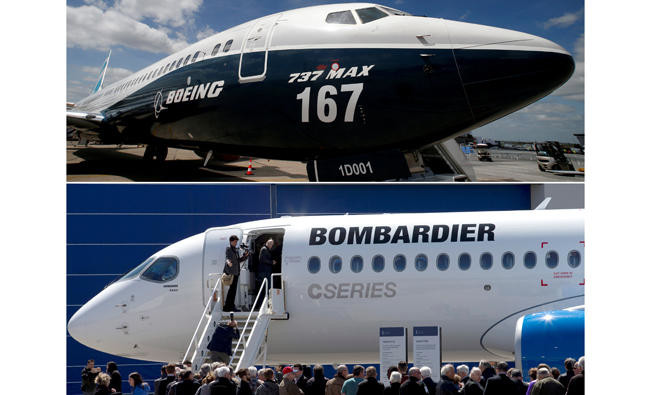
Fintech firm Hala gets SAMA approval to offer debt-based crowdfunding solutions

RIYADH: Saudi businesses are set to gain access to new crowdfunding solutions as Hala Payments Co. has received licensing approval from the Kingdom’s central bank to offer debt-based products.
The Saudi-based fintech platform offers inbound and outbound payment options to small and medium enterprises, with over 50,000 merchants currently using its services, according to its website.
With this approval, the total number of companies licensed to engage in this activity in the Kingdom has reached 11, while authorized finance companies now stands at 62, stated the Saudi Central Bank in a press release.
Debt-based crowdfunding provides a pathway for projects or businesses in need of funding. Instead of relying on a single lender, borrowers secure loans from multiple investors.
This model is particularly advantageous for small businesses or individuals who may face challenges obtaining loans from traditional banks. Essentially, it serves as a dual opportunity: borrowers receive the necessary funding, while investors earn returns by directly lending money.
In January, SAMA issued a license to Thara, a debt crowdfunding platform, to operate in the Kingdom. The fintech firm specializes in financing real estate development projects, connecting individual and institutional investors with investment opportunities through Murabaha products.
This decision to issue licenses falls within the framework of the central bank’s efforts to support and empower the finance sector, aimed at enhancing the effectiveness and flexibility of transactions, added SAMA.
It also seeks to foster innovation and promote it, with the objective of enhancing the level of financial inclusion in the Kingdom and extending such services to all segments of society.
SAMA emphasized the importance of dealing with licensed or authorized financial institutions, which can be verified by visiting its official website.
The central bank warned that it may take any necessary actions, such as conducting on-site visits, meeting with the company’s executives, and reviewing its regulations, procedures, and records, to verify that the debt-based crowdfunding company has met all its requirements.
It added that the license can be canceled if the firm requests cancellation, provides false information, violates rules or laws, delays starting activities for six months, or suspends operations for over three months without SAMA’s approval.
Mawani issues new licenses to strengthen ports sector in Saudi Arabia

RIYADH: The Kingdom’s seaport activities and logistics sector are set to improve, with the Saudi Ports Authority issuing new licenses in multiple areas of operation.
In a press statement, the authority, also known as Mawani, said that issuing these permits aligns with its goal of developing port business in the Kingdom with high efficiency and quality.
Mawani revealed that permits have been issued in various areas of operations, including pilotage, maritime support, marine traffic signals, and ship repair and routine maintenance.
The statement added that licenses were also issued for container handling and port storage services, and maritime consultancy activities.
The issuance of these new permits is part of Mawani’s broader strategy to position Saudi Arabia as a global logistics hub by the end of this decade.
Saudi Arabia’s National Transport and Logistics Strategy seeks to increase the sector’s contribution to the Kingdom’s gross domestic product to 10 percent from the current 6 percent by 2030.
In the statement, Mawani further revealed that additional licenses were given to activities like bunkering ships in terminals, waste recycling and ship waste management, as well as, hydrographic surveying, and port work training.
In January, the authority announced that it established new ship anchorage areas in the Kingdom’s King Fahd Industrial Port in Yanbu.
According to a statement, newly established docking zones will help modernize several port logistical services, including delivering ships with supplies and fuels, said Mawani in a statement.
The body also noted that these new anchorage zones will increase the terminal’s operational performance indicators and reduce ship docking times.
In December 2023, Mawani garnered 79.01 points in the UN Conference on Trade and Development’s Liner Shipping Connectivity Index for the fourth quarter of 2023, compared to 77.66 points issued in the previous three months.
Moreover, Saudi Arabia also progressed in container handling, moving from 24th to 16th in the Lloyd’s List One Hundred Ports rankings.
Similarly, the Kingdom climbed 17 places in the World Bank’s Logistics Performance Index, securing the 38th position out of 160 countries.
Oil Updates – prices rise on slower US inflation, strong demand

SINGAPORE: Oil prices extended gains from the previous session on Thursday on signs of stronger demand in the US, where data showed slower inflation than markets expected, bolstering the argument for an interest rate cut that could drive greater consumption, according to Reuters.
Brent futures rose 32 cents, or 0.4 percent, to $83.07 a barrel at 9:20 a.m. Saudi time, while US West Texas Intermediate crude gained 31 cents, or 0.4 percent, to $78.94.
“A more tamed read for US April inflation and a far weaker-than-expected read in US retail sales seem to offer room for the Fed to consider earlier rate cuts, with market expectations leaning more firmly for policy easing to kickstart in September this year,” said IG market strategist Yeap Jun Rong.
“The larger-than-expected drawdown in US crude inventories for last week also offered some calm, while geopolitical tensions continue to rock on in the Middle East.”
US consumer prices rose less than expected in April in a boost to financial market expectations for a September rate cut by the Federal Reserve, which could temper dollar strength and make oil more affordable for holders of other currencies.
Elsewhere, US crude oil, gasoline and distillate inventories fell, reflecting a rise in both refining activity and fuel demand, showed data from the Energy Information Administration.
Crude inventories fell 2.5 million barrels to 457 million barrels in the week ended May 10, the EIA said, versus the 543,000 barrel consensus analyst forecast in a Reuters poll.
Signs of slowing inflation and stronger demand were supporting prices, ANZ Research also said in a client note, as is geopolitical risk, which it noted remains elevated.
In the Middle East, Israeli troops battled Hamas militants across Gaza, including Rafah, which had been a civilian refuge.
Ceasefire talks mediated by Qatar and Egypt are at a stalemate, with Hamas demanding an end to attacks and Israel refusing until the group is annihilated.
Gains were constrained after the IEA trimmed its forecast for 2024 oil demand growth, widening the gap between its view and that of producer group OPEC.
Global oil demand this year will grow by 1.1 million barrels per day, the IEA said, down 140,000 bpd from its previous forecast, largely due to weak demand in developed nations of the Organization for Economic Co-operation and Development.
Saudi minister and US counterpart agree road map for cooperation in energy sector

- During meeting in Riyadh, Prince Abdulaziz bin Salman and Jennifer Granholm discuss ways to enhance energy-related collaborations
- They also review Kingdom’s efforts to tackle climate change through local and regional initiatives, including the Saudi and the Middle East green initiatives
RIYADH: The Saudi minister of energy, Prince Abdulaziz bin Salman, and the US secretary of energy, Jennifer Granholm, on Wednesday agreed a road map for cooperation between the countries in the sector.
During a meeting in Riyadh, they also discussed ways in which collaborations might be enhanced in energy-related fields such as carbon management, clean hydrogen, nuclear energy, electricity and renewables, innovation, energy-sector supply chain resilience, and energy efficiency. The two countries signed a Partnership Framework for Advancing Clean Energy in July, 2022.
The officials also reviewed the Kingdom’s efforts to tackle climate change through local and regional initiatives based on a circular carbon economy, including the Saudi and the Middle East green initiatives, the ministry said.
The new road map represents a joint plan for energy cooperation that establishes a timeline and outlines critical projects for collaboration, officials said.
Both sides agreed to engage in various activities to implement the road map, including: exchanges of knowledge on policies related to the joint plans, such as standards and regulatory frameworks; enhancement of joint research and development, especially in the field of new technologies; and the building of human capital through training and exchanges of expertise.
Saudi Center for Space Futures will support lunar mission and $2tn global space economy, NASA chief tells Asharq TV

- New center will bring space industries together with government programs, says Bill Nelson on Riyadh visit
- NASA plans to “go back to the moon” with commercial and international partners, agency chief tells Maya Hojeij
RIYADH: The Center for Space Futures, hosted by the Saudi Space Agency, will bring together space industries to send a mission to the moon and build a $2 trillion global space economy by 2035, NASA Administrator Bill Nelson has said.
During a visit to Riyadh this week, the US space agency chief said in a special interview with the Asharq TV channel: “The future of the space center is to bring together space industries, commercial companies, together with the government programs.”
On April 29, the Saudi Space Agency and the World Economic Forum signed an agreement to establish a Centre for the Fourth Industrial Revolution focused on space.
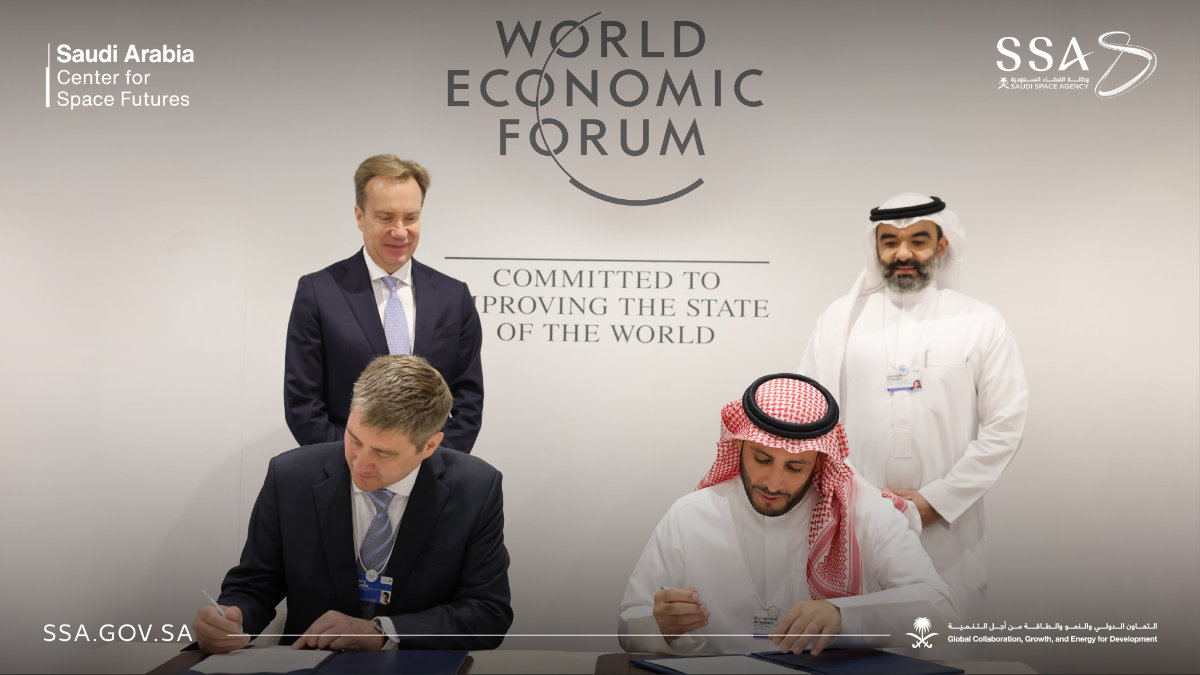
Set to open in the fall of 2024, the Center for Space Futures will be the first center in the C4IR network. It aims to facilitate public-private discussions on space collaboration and contribute to accelerating space technologies.
Nelson told business anchor Maya Hojeij that, after a hiatus of half a century, NASA plans to “go back to the moon.” However, he added: “This time with not only commercial partners, but also with international partners.”
He highlighted that the Center for Space Futures will “bring together those commercial and government programs in order to build a significant space economy.”
Earlier this year, NASA announced that its Artemis II lunar mission will aim to land the first astronauts near the moon’s South Pole in September 2025.
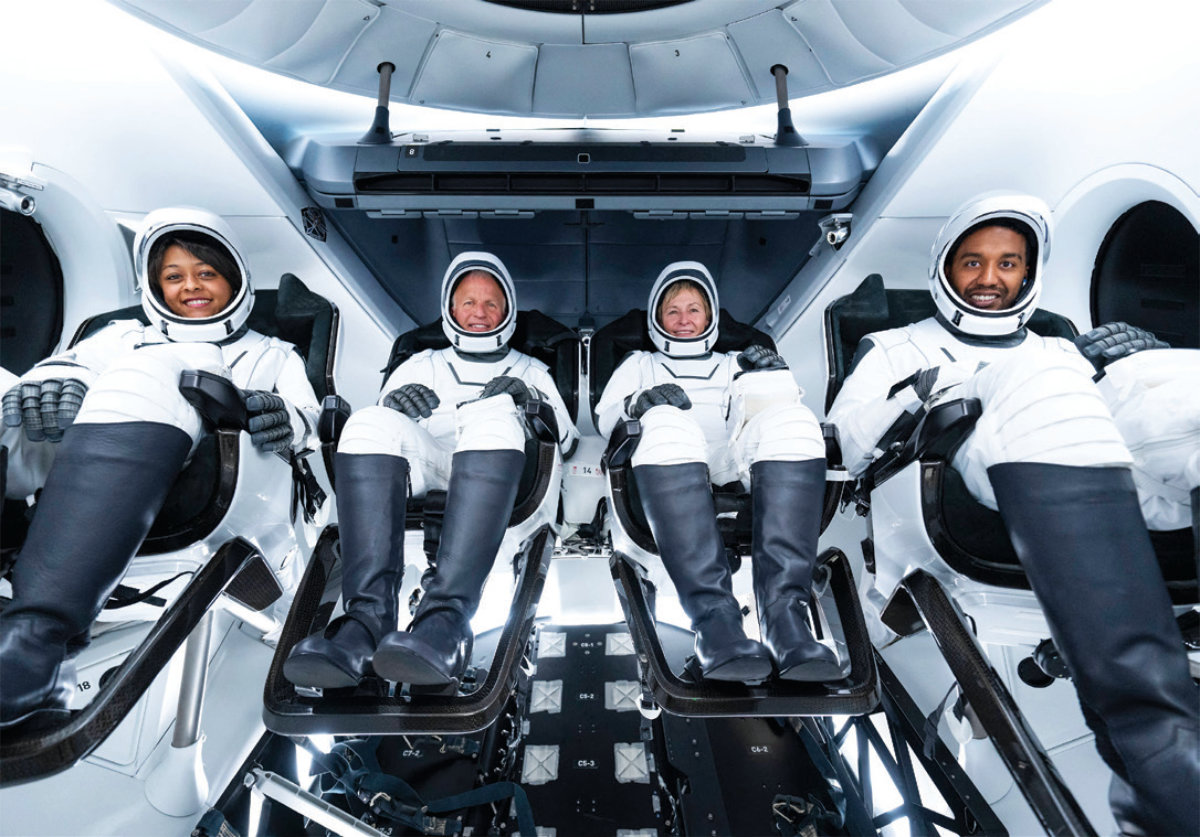
NASA’s administrator added: “We’re talking about a space economy that will be almost $2 trillion dollars by the year 2035 — only a little over a decade away — a significant part of the economic sector of a country.”
Elaborating, he said that the “$2 trillion is worldwide. And that is a lot of startup companies, such as I have seen here in Riyadh today, that are partnering with other companies from around the world that are including incentives by the Saudi government.
“So, we do that in America, and that’s where I mentioned that we’re going back to the moon, this time after a half century, because we were on the moon a half-century ago.
“This time, we’re going back to the moon for a different reason, we’re going to learn, to invent, to create in order to be able to go to Mars and beyond. And this time we go back with commercial enterprises.”
NASA’s Apollo 17, which celebrated its 50th anniversary in December 2022, was the space agency’s sixth and final mission to land people on the moon.
The mission landed on the Taurus-Littrow site, which offered a mix of mountainous highlands and valley lowlands, allowing the crew to collect 741 lunar samples.
Nelson told Asharq’s Hojeij that NASA has partnered with Saudi Arabia on multiple scientific instruments to send Artemis II to the moon for economic benefits and to better understand climate change.
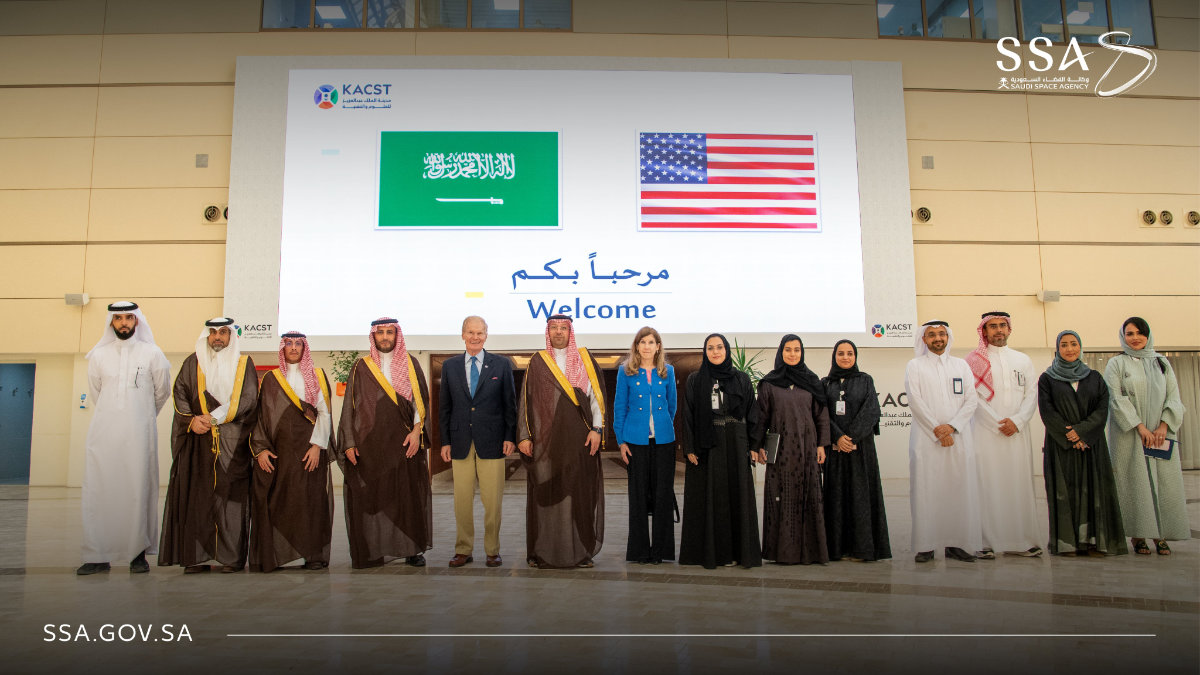
“We have a partnership with Saudi Arabia,” he said. “We’ve already partnered on a number of scientific instruments, but we’ve got a whole way to go.
“We’re going back to the moon and then we’re going to Mars. We are constantly looking down on Earth to help our climate, to better understand what is happening to the Earth, to give very precise measurements of exactly what’s happening there.
“We’re going to coordinate and partner with Saudi Arabia on all of these things.”
Asked about space challenges and how the partnership between Riyadh and Washington sought to address them, Nelson said that debris in space was among the biggest threats to satellites and spacecraft.
“Debris in space is a major problem,” he said. “We are too often having to move our International Space Station to get it out of the way of a piece of space junk that otherwise could hit it.
“Same thing with a lot of our satellites. And so that applies to everybody’s satellites, not just US satellites, Saudi satellites.”
Nelson added that NASA was working with partners “to come up with systems and mechanisms by which we can require the manufacturers of satellites to be able, after their useful life, have a precise landing back through the Earth’s atmosphere to burn up and if any pieces are left over, that they would fall harmlessly in the southern Pacific Ocean.”
Underscoring the importance of these efforts, he said that “whenever something is left in space, it becomes a dangerous projectile that could always ram into something, like our space station.”
The UNU Institute for Environment and Human Security, in its Interconnected Disaster Risks 2023 report, included space debris among its six risk tipping points.
The report, released in February, found that there were 35,150 tracked objects in orbit in 2023. Just 25 percent of these were working satellites while the rest were considered junk, including broken satellites and rocket parts.

As objects in space travel at speeds exceeding 25,000 km per hour, any collision may be “catastrophic,” and even the smallest objects can cause significant damage, according to the same UNU-EHS report.
Asked about the Artemis Accords, which Saudi Arabia signed in 2022, the NASA administrator described it as “a common sense set of principles of the peaceful uses of space.
“For example, in the Artemis Accords, we have that you would come to the aid and assistance of a nation that would have a problem in space,” he said.
“We would develop common elements so that you could help each other out, perhaps remotely in space. But, basically, the thrust of it is the peaceful use of space.”
Saudi Arabia is the 21st country globally and the fourth Middle Eastern nation to sign the Artemis Accords, which set out common principles, guidelines and best practices to ensure safe, peaceful and sustainable space exploration.
Nelson’s visit to the Kingdom is intended to explore future collaboration between the US space agency and key government officials, while also emphasizing the significance of civil space cooperation in the broader US-Saudi relationship
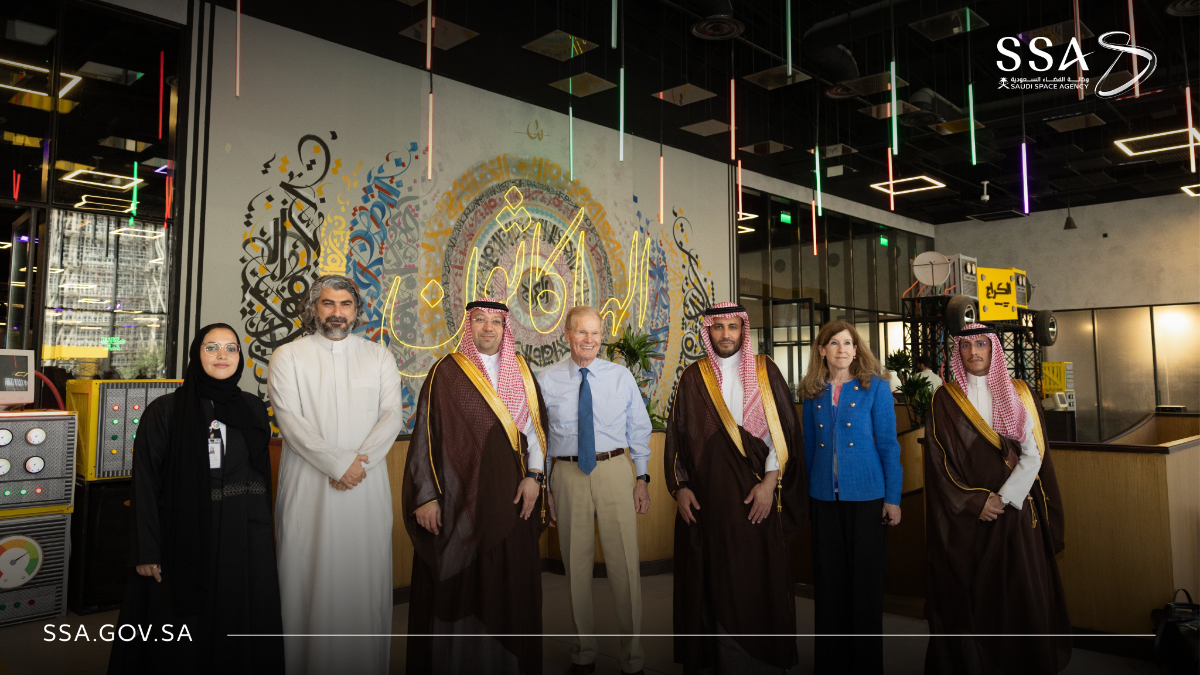
The Saudi Space Agency was launched by royal decree in December 2018 to accelerate economic diversification, enhance research and development, and raise private-sector participation in the global space industry.
Since its launch, the Kingdom’s state-funded space program has struck deals with several of the world’s established space agencies, astronautical companies and top universities to benefit from advanced technological cooperation.
Saudi Arabia’s space industry holds great potential for growth after recording $400 million in revenue in 2022, according to a report by the Saudi Communications, Space and Technology Commission published late last year.
The global space economy is projected to expand to $1.8 trillion by 2035, marking a threefold increase from $630 billion in 2023, according to research published by the World Economic Forum in April.
A growing number of businesses across sectors including agriculture, construction, insurance and climate-change mitigation, are expected to drive the new and expanding space economy.
This rapid surge is being driven by reduced costs and broader accessibility to space-enabled technologies, encompassing various commercial sectors such as communications, positioning, navigation, timing, Earth observation services, tourism and manufacturing.
While state-sponsored investments will remain the cornerstone of the industry, enhanced collaboration between various stakeholders across public and private sectors will be increasingly important to fully realize the sector’s potential in the future.



